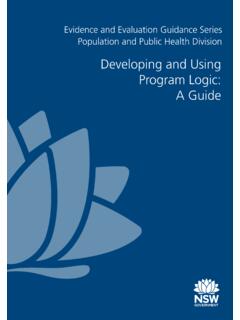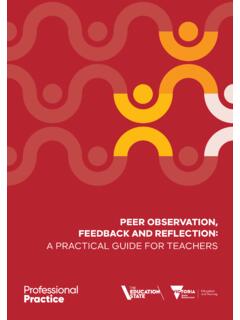Transcription of Preventing Crime: What Works, What Doesn't, What's Promising
1 Department of JusticeOffice of Justice ProgramsNational Institute of JusticeR e s e a r c h i n B r i e fNational Institute of JusticeJeremy Travis, DEPARTMENTOFJUSTICE OFFICEOFJUSTICEPROGRAMSBJANIJOJJDPBJSOVC P reventing Crime: What Works, What Doesn t, What s Promisingby Lawrence W. Sherman, Denise C. Gottfredson, Doris L. MacKenzie, John Eck,Peter Reuter, and Shawn D. BushwayJuly 1998 These are the major conclusions of a1997 report to Congress, which was basedon a systematic review of more than 500scientific evaluations of crime preventionpractices. This Research in Brief summa-rizes the research methods and conclu-sions found in that 1996, a Federal law required Attorney General to provide Con-gress with an independent review of theMany crime prevention programs don t.
2 Most programs have not yetbeen evaluated with enough scientificevidence to draw conclusions. Enoughevidence is available, however, to createprovisional lists of what works, whatdoesn t, and what s Promising . Thoselists will grow more quickly if the Nationinvests more resources in scientificevaluations to hold all crime preventionprograms accountable for their and FindingsDiscussed in this Brief: A con-gressionally mandated evaluationof State and local crime preventionprograms funded by the of issues: What works to pre-vent crime, especially youth vio-lence? Out of all the hundreds ofdifferent strategies used in com-munities, families, schools, labormarkets, places, police, and crimi-nal justice, which ones succeed,and to what extent?
3 What doesthe scientific evidence suggestabout the effectiveness of federallyfunded crime prevention?Key findings: Very few opera-tional crime prevention programshave been evaluated using scien-tifically recognized standards andmethodologies, including repeatedtests under similar and differentsocial settings. Based on a reviewof more than 500 prevention pro-gram evaluations meeting mini-mum scientific standards, thereport concludes that there is mini-mally adequate evidence to estab-lish a provisional list of whatworks, what doesn t, and what spromising. The evidence is currentas of late 1996 when the literature For infants: Frequent home visitsby nurses and other professionals.
4 For preschoolers: Classes with weeklyhome visits by preschool teachers. For delinquent and at-riskpreadolescents: Family therapy andparent training. For schools: Organizational development forinnovation. Communication and reinforcement ofclear, consistent norms. Teaching of social competency skills. coaching of high-risk youth in thinking skills. For older male ex-offenders:Vocational training. For rental housing with drug dealing:Nuisance abatement action on landlords. For high-crime hot spots: Extra policepatrols. For high-risk repeat offenders: Monitoring by specialized police units. Incarceration. For domestic abusers who areemployed: On-scene arrests.
5 For convicted offenders: Rehabilitationprograms with risk-focused treatments. For drug-using offenders in prison:Therapeutic community Works?2R e s e a r c h i n B r i e f In places (such as businesses,hotels, and other locations).2 By police. By criminal justice agencies prevention programs in each ofthese settings are legally eligible for Jus-tice Department crime prevention fund-ing. However, because Congress requiresthat most funding decisions about spe-cific programs be decentralized to Stateand local governments, no detailedbreakdown of funding is available by set-ting or by program. The review focusedon whether there is scientific evidencefavoring the types of programs that areeligible for funding, showing they canaccomplish their Research in Brief describes the sci-entific methodologies used to perform thereview as well as the limitations of theavailable data.
6 It then summarizes theconclusions reached by the authors to de-velop three separate lists of programs forwhich a minimum level of scientific evi-dence was available: what works, whatdoesn t, and what s Promising . The textprovides more details on the evaluationsof each type of program as well as cita-tions to the sources of data the authorsreviewed to reach their : The page references in brackets anditalics that follow the bibliographic cita-tions refer the reader to the pages in theprinted version of the full 1997 report toCongress where the authors discuss thetopics in greater science of crimepreventionTo most practitioners, crime prevention isan art. But as the Congress indicatedin the law requiring this report, the artof crime prevention (like the art of medi-cine) can be evaluated and guided by theeffectiveness of State and local crimeprevention assistance programs fundedby the Department of Justice, withspecial emphasis on factors that relateto juvenile crime and the effect of theseprograms on youth violence.
7 The lawrequired that the review employ rigorousand scientifically recognized standardsand methodologies. Framers of thelaw expected that the evaluation wouldmeasure: (a) reductions in delinquency, juvenilecrime, youth gang activity, youth sub-stance abuse, and other high-risk factors;(b) reductions in the risk factors in thecommunity, schools, and family environ-ments that contribute to juvenile vio-lence; and (c) increases in the protectivefactors that reduce the likelihood of de-linquency and criminal behavior. 1 After an external, peer-reviewed competi-tion, the National Institute of Justice se-lected the proposal of a group from theUniversity of Maryland s Department ofCriminology and Criminal Justice to per-form the review defined crime prevention broadly as any practice shown to result inless crime than would occur without thepractice.
8 It also examined any programthat claims to prevent crime or drugabuse, especially youth violence, and, inaccordance with the congressional man-date, examined the effects of programs onrisk and protective factors for youth vio-lence and drug meeting any of these criteriawere classified into seven local institu-tional settings in which these practicesoperated: In communities. In families. In schools. In labor was completed and is ex-pected to change continually asmore program evaluation findingsare completed and audience: Federal, State,and local policymakers; criminaland juvenile justice professionals,practitioners, and researchers; edu-cators; and leaders of communityorganizations promoting preven-tion of crime, juvenile delinquency,and drug : The most recent lists ofwhat works, what doesn t, andwhat s Promising are regularlyupdated at the University ofMaryland Web site, The fulltext of the 1997 report, this Re-search in Brief, and annual updatescan all be downloaded from thatWeb and e s e a r c h i n B r i e fdetail in standard texts, notably Cookand Campbell (1979).
9 In the course ofpreparing this review, the authors de-veloped a shorthand means of summa-rizing these rules called the MarylandScale of Scientific Methods [see pp. 2 15 to 2 19 and the Appendix]. Thisscale was modified from a similar sys-tem for coding evaluations in a majorreview of drug prevention work per-formed by the Center for SubstanceAbuse Prevention (1995) and was laterfound to be similar to scales used toassess the internal validity of clinicaltrials in medicine (Millenson, 1997,p. 131). These standards for assessinginternal validity have been developedover the past century in a wide rangeof fields and are directly responsive tothe congressional mandate to employ rigorous and scientifically recognizedstandards and methodologies in pre-paring the methodsDeciding what works in the preventionof crime called for applying rigorousmeans for determining which programshave had a demonstrated impact on thereduction of crime and search for impactevaluationsThe first step was to identify and re-view reports evaluating the effective-ness of crime prevention versus process primary factor used to select suchevaluations was evidence about theimpact of
10 Programs on crime. Manyevaluations funded by the FederalGovernment perhaps the majority are process evaluations describingwhat was done, rather than impact evaluations assessing what effect theprogram had on crime. While processscience of measuring program evaluations of crime preven-tion have both limitations and major limitation is that scientificknowledge is provisional, because theaccuracy of generalizations to all pro-grams drawn from one or even severaltests of specific programs is alwaysuncertain. The major strength of scien-tific evaluations is that rules of scienceprovide a consistent and reasonablyobjective way to draw conclusions aboutcause and knowledge is provi-sional.















